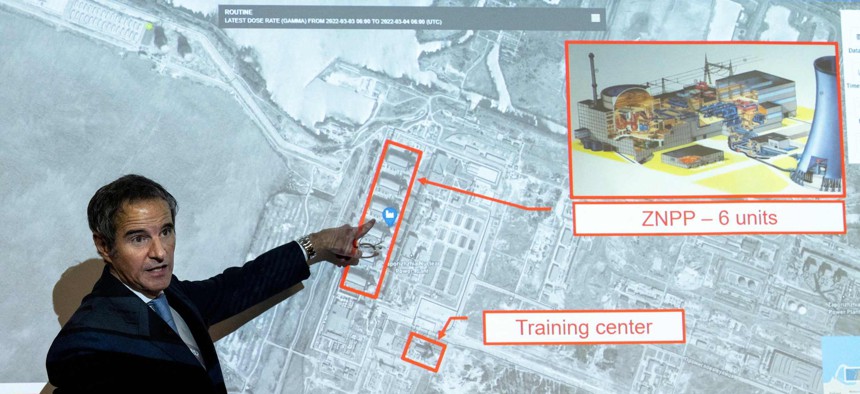
The International Atomic Energy Agency's Rafael Grossi describes damage done by Russian forces to the Ukrainian Zaporizhzhia nuclear power plant. He spoke at IAEA headquarters in Vienna, Austria, on March 4, 2022. JOE KLAMAR/AFP via Getty Images
What We Learned from Russia’s Assaults on Nuclear Plants
Governments, international organizations, and nuclear plant operators have a lot of work to do.
Immediate disaster was averted during Russia’s military assault on two Ukrainian nuclear facilities, but the events unfolding there have implications for nuclear safety and security both in Ukraine and around the world.
Nuclear facilities are designed to ward off a wide range of threats by non-state terrorists, who are generally not capable of marshalling military forces and weapons on par with a nation. While such facilities should not be required to fight off an invading army, governments must now consider how to prepare for their safety and security in such a scenario.
National governments and international institutions should begin by strengthening norms against attacks on civilian nuclear facilities. While Russia’s invasion is the first full-scale war in a country with a large nuclear infrastructure, nations had envisioned this situation. In 1988, India and Pakistan agreed to a prohibition on “any action aimed at causing the destruction of, or damage to, any nuclear installation or facility in the other country.” In 2009, the International Atomic Energy Agency, or IAEA, General Conference endorsed a statement prohibiting the “armed attack or threat of attack against nuclear installations, during operation or under construction.” Additionally, Russia’s attacks run contrary to the Geneva Convention, international humanitarian law, and even Russian military doctrine. Governments should build on these norms and legal precedents and pursue further international agreements that nuclear facilities should be protected in war zones. The agreements should not only cover direct assault from an attacking army, but also incidental damage arising in war zones.
International institutions like the IAEA can also play a critical role in the safety and security of nuclear facilities in a war zone. Director General Rafael Grossi and his staff are working tirelessly to guarantee the safety of nuclear facilities and personnel in war-torn Ukraine and the IAEA is also serving as a crucial conduit for up-to-date information about the safety, security, and safeguards status of the Ukrainian nuclear facilities. Recognizing the IAEA’s important roles, four members of Congress have urged President Biden to “take any available action to encourage the IAEA’s involvement in monitoring the situation in Ukraine, identifying any necessary action that may be advisable, and recommending all necessary cautionary action required for the utmost safety.”
Nuclear operators and regulators should develop plans to minimize the risk to a nuclear facility during a military crisis and train staff on how to execute those plans. The IAEA should consider preparing guidance on how to confront safety, security, and safeguards challenges at nuclear facilities in these situations. The guidance might include recommendations, for example, on when to shut down reactors, what additional supplies (food, water, fuel, lodging, etc.) might be needed, when additional redundant systems for power are needed, and when and if to distribute potassium iodide. Based on its experience in Ukraine, the IAEA might also consider developing a service to verify basic capabilities that should be in place for nuclear facilities in war zones.
Sadly, even as this tragedy continues to unfold, it is important to recognize this is not the first crisis nuclear operators have had to face. Nor will it be the last. The COVID-19 pandemic, increasing risk of wildfires near nuclear facilities, and political instability around the world signal a future where nuclear operators will need to be resilient and adapt to crises. While the measures we propose may provide little solace to those currently working at nuclear facilities in Ukraine, they may help save lives in the future.
Ernest J. Moniz served as U.S. Secretary of Energy and is Co-Chair and CEO of the Nuclear Threat Initiative. Richard A. Meserve is a former Chairman of the U.S. Nuclear Regulatory Commission and is a Senior Of Counsel with Covington & Burling LLP.




